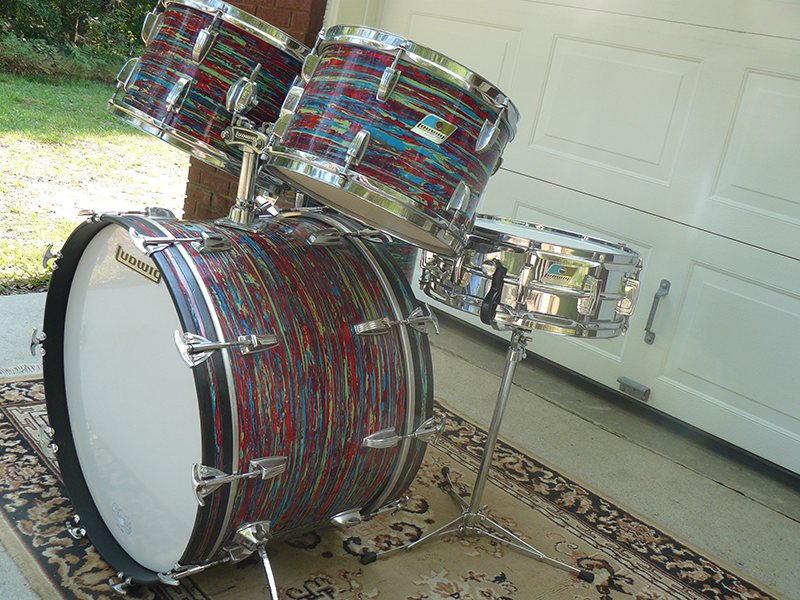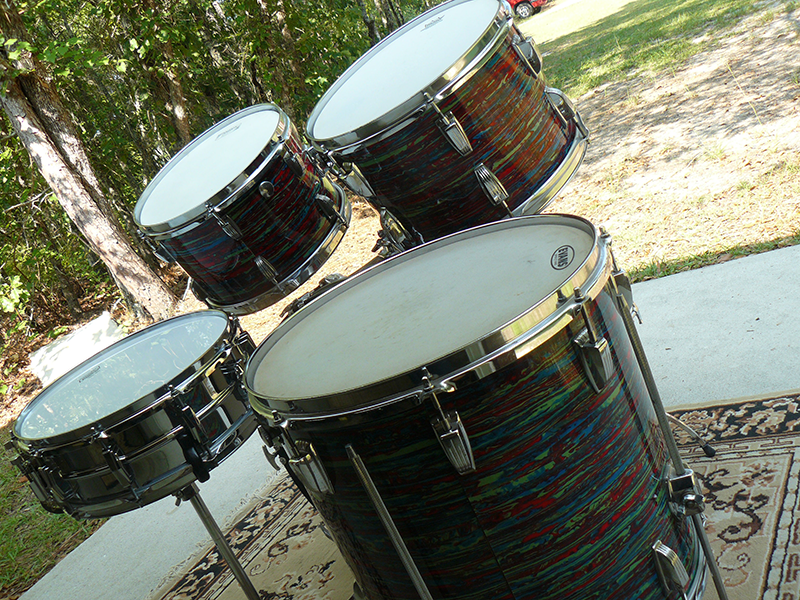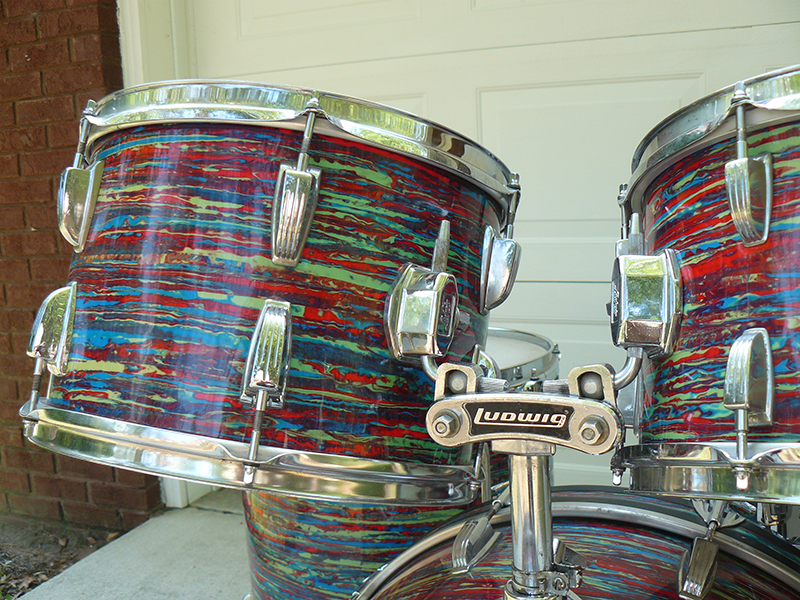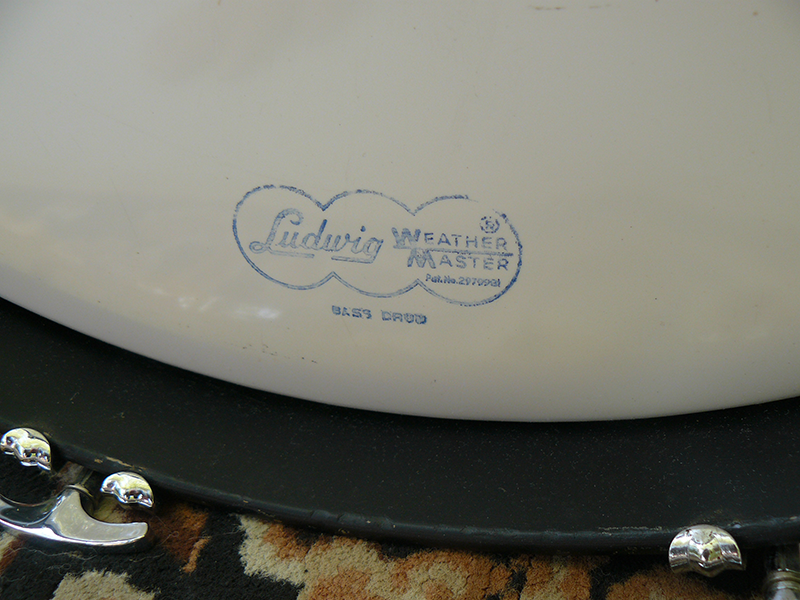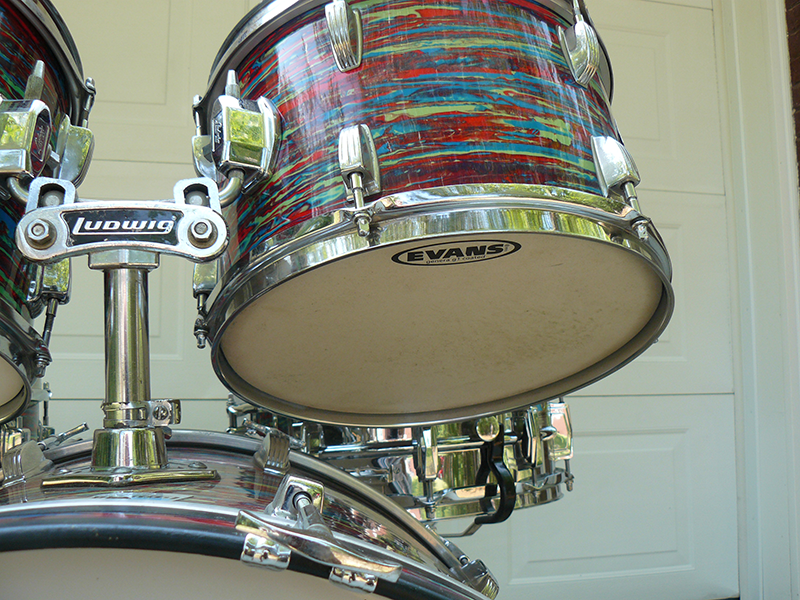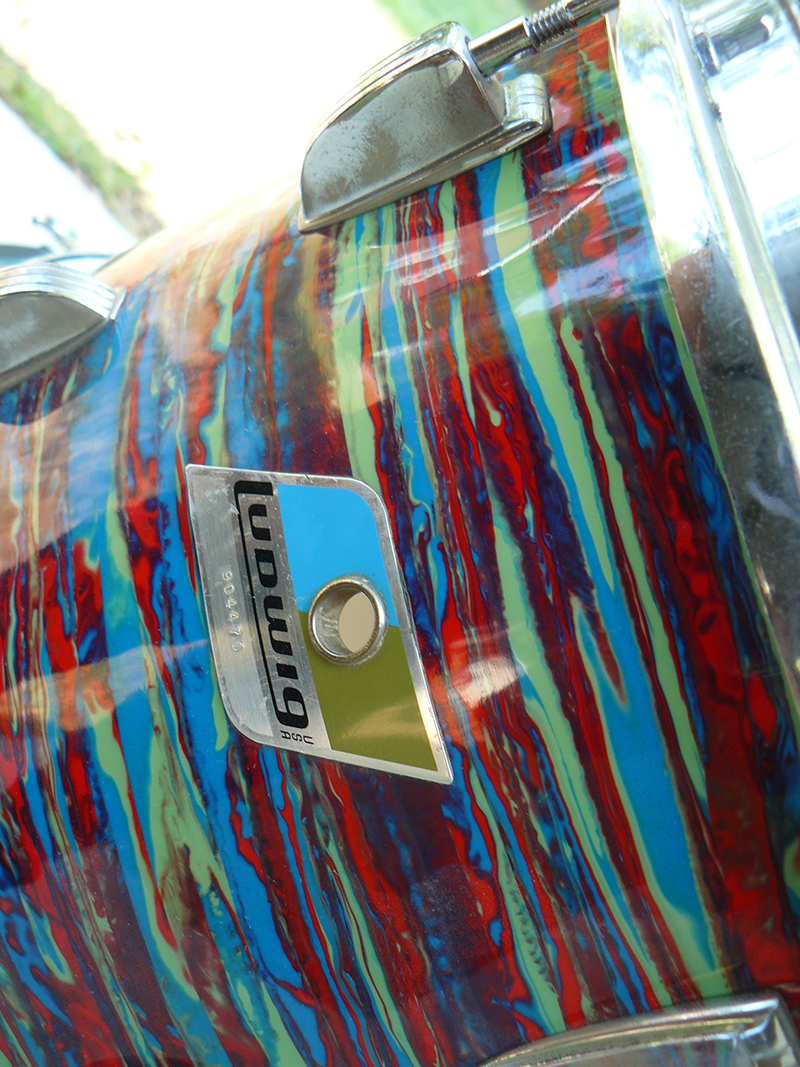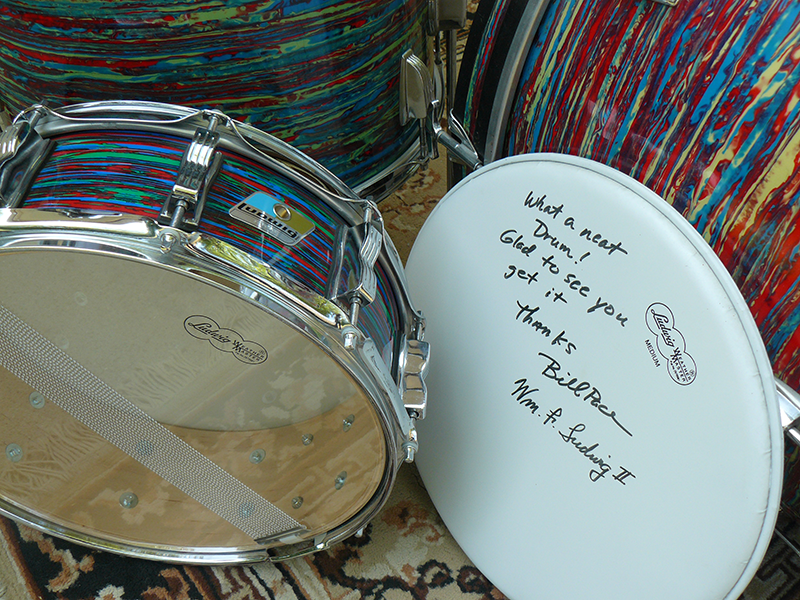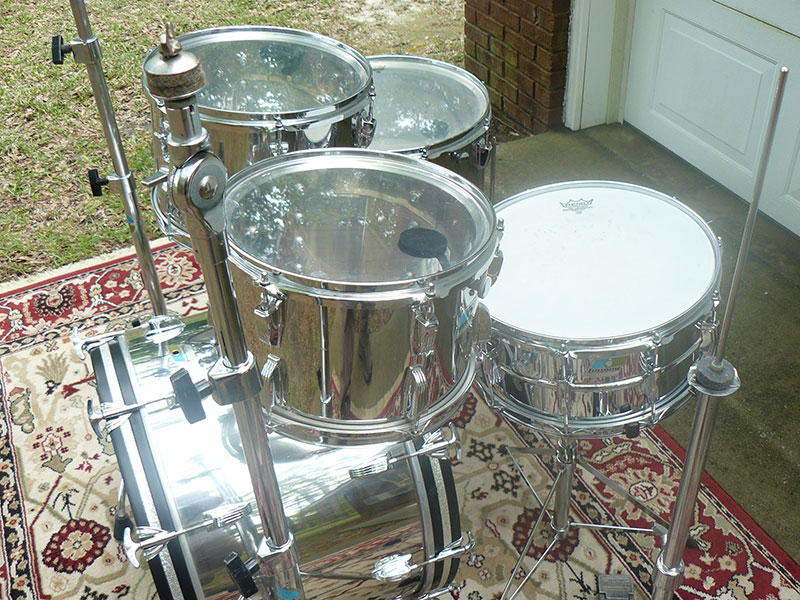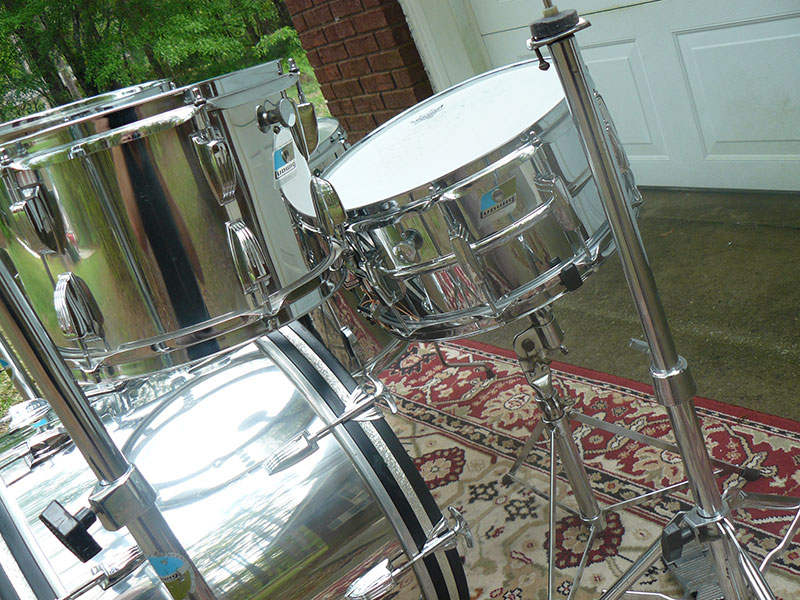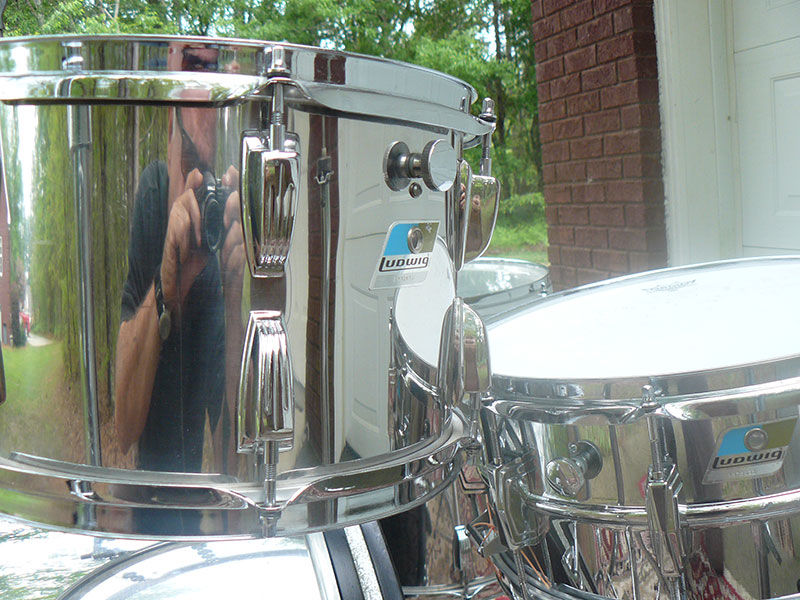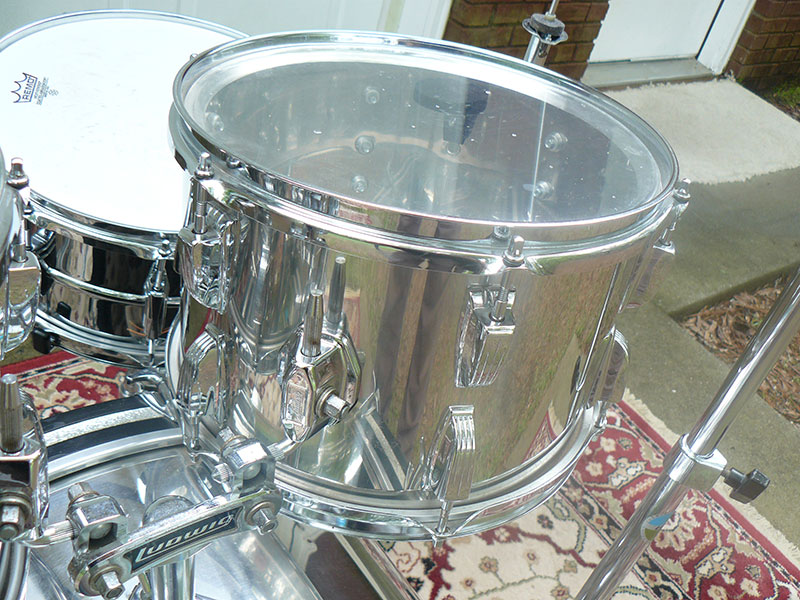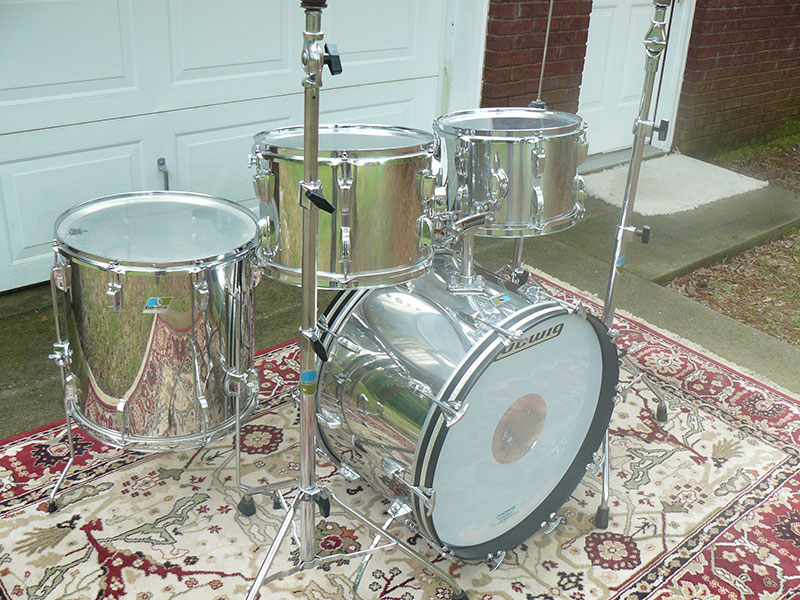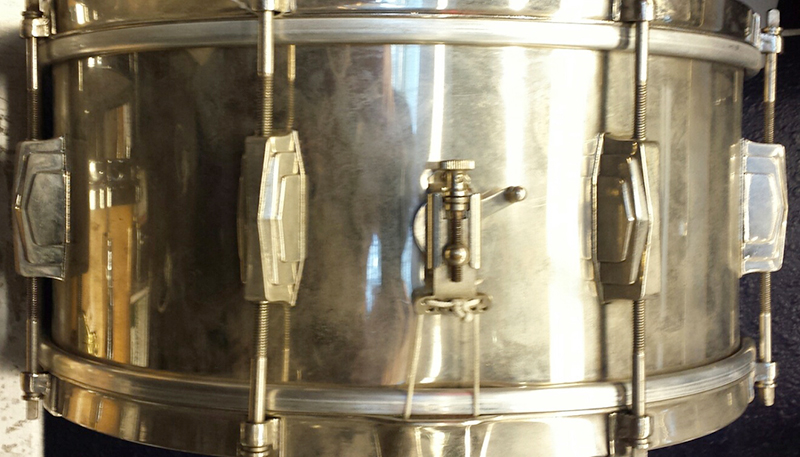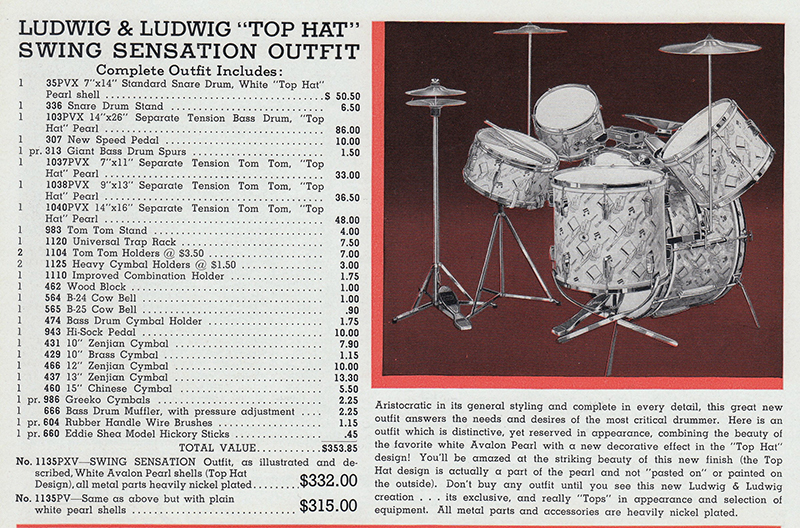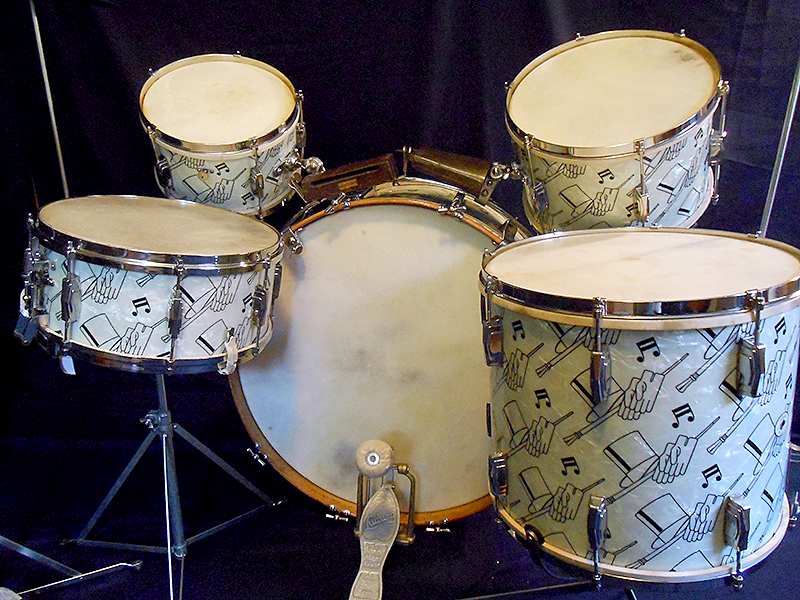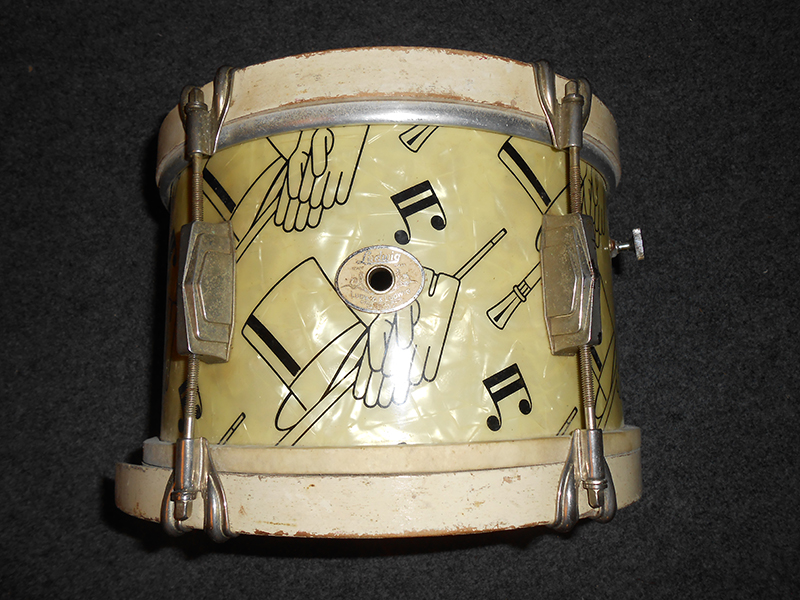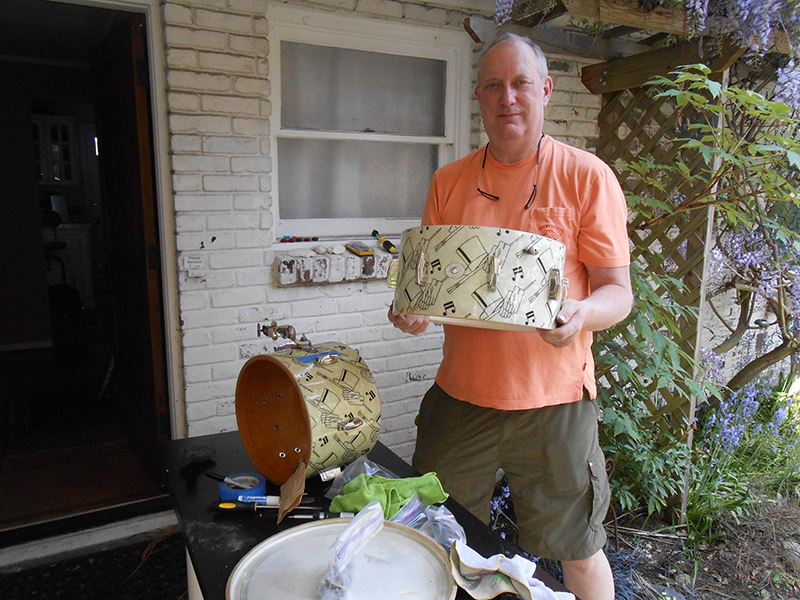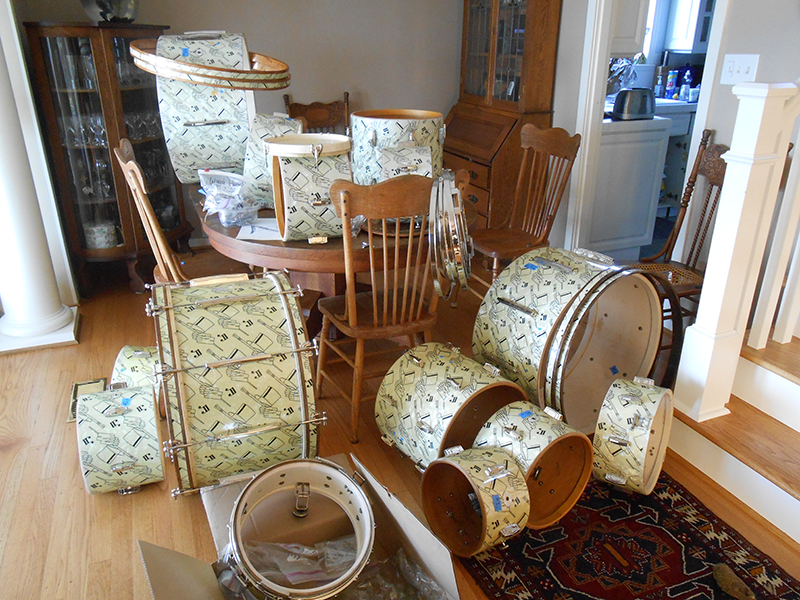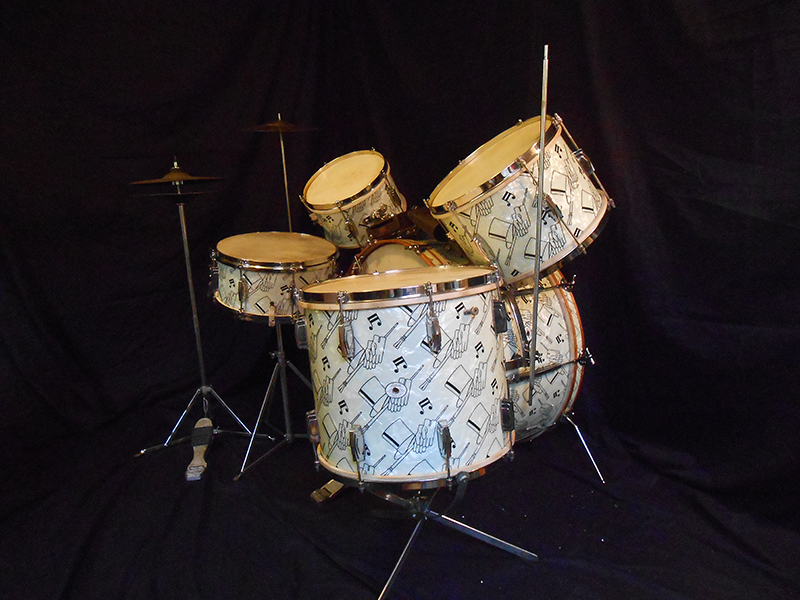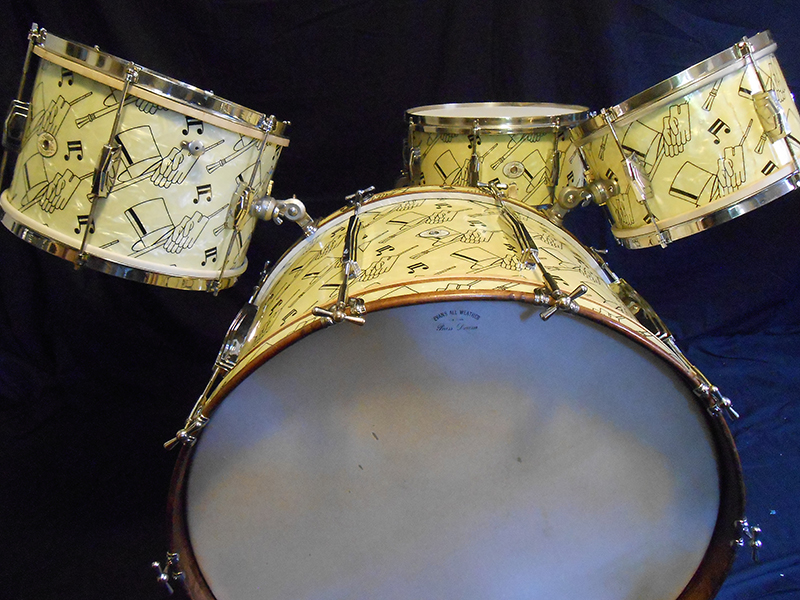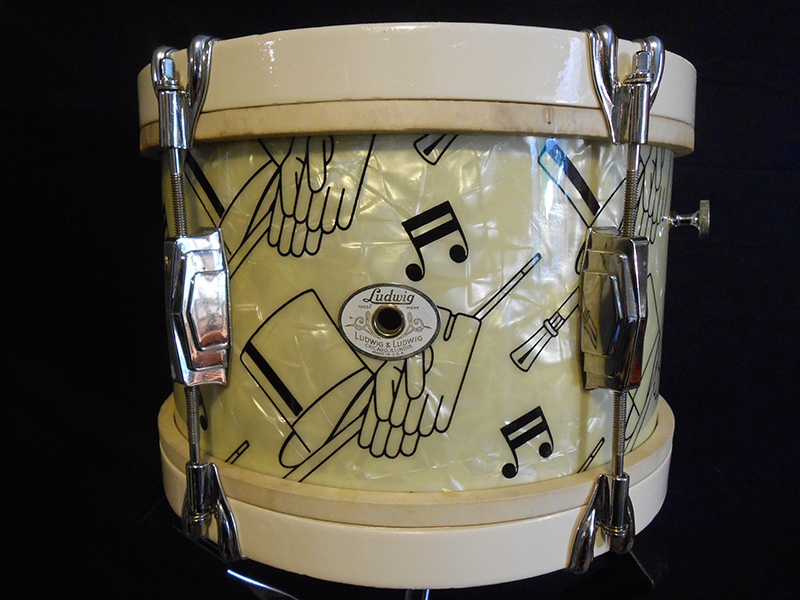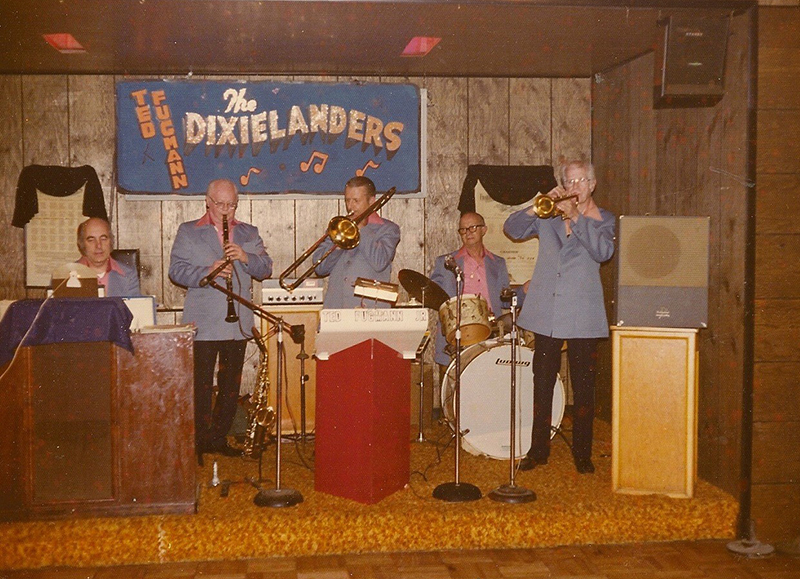All my items I have listed on DrumSellers.com have been repriced with “or best offer”. This includes all snare drums, drum sets, cymbals of mine and of those consigned to me by Steve Johnson, Tom Boyle, John Dittrich, and Jason Cooper. Well over 300 cymbals, 50 snare drums and several drum sets. This
Read more1960s Ludwig Hollywood Set
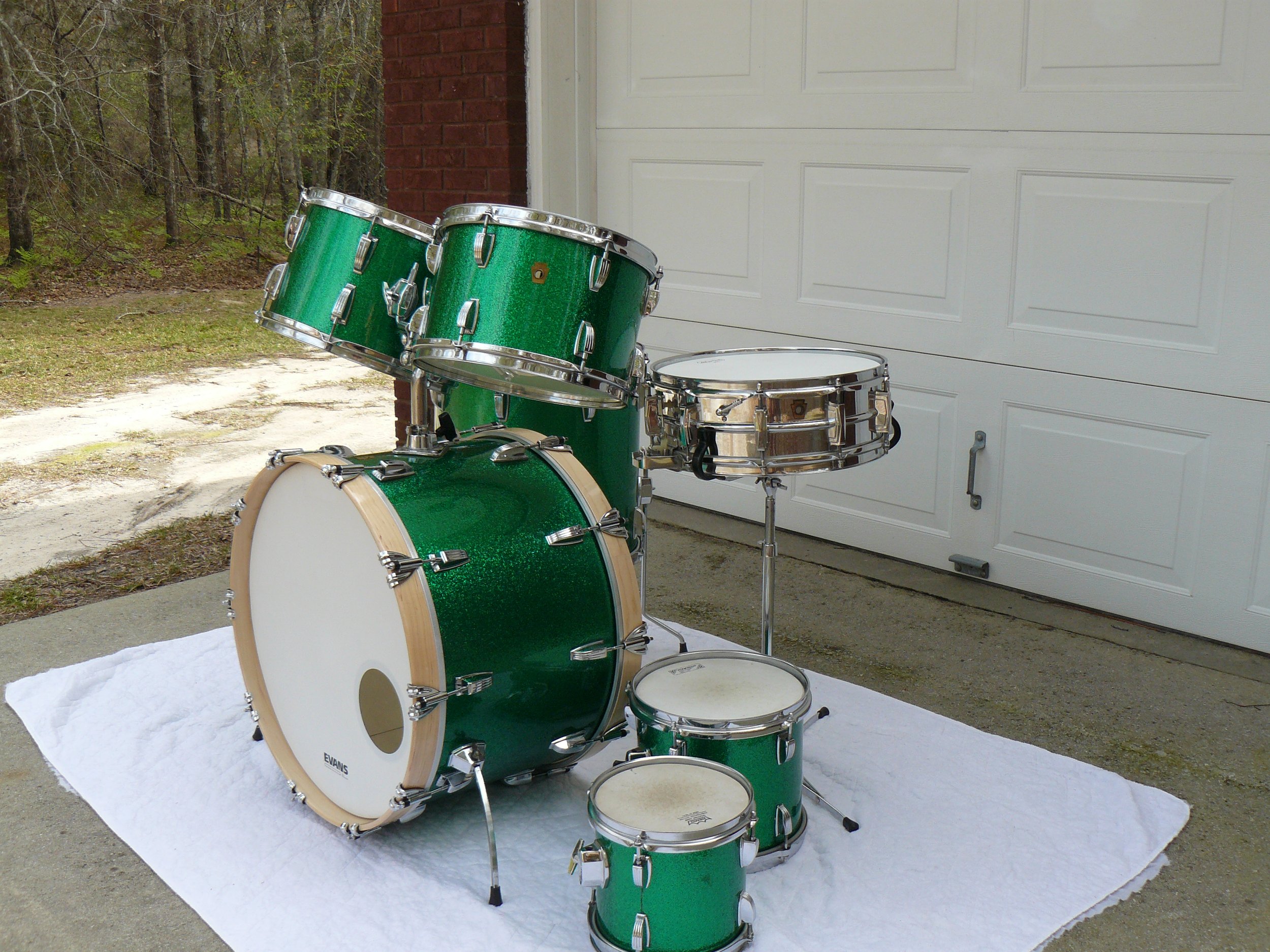
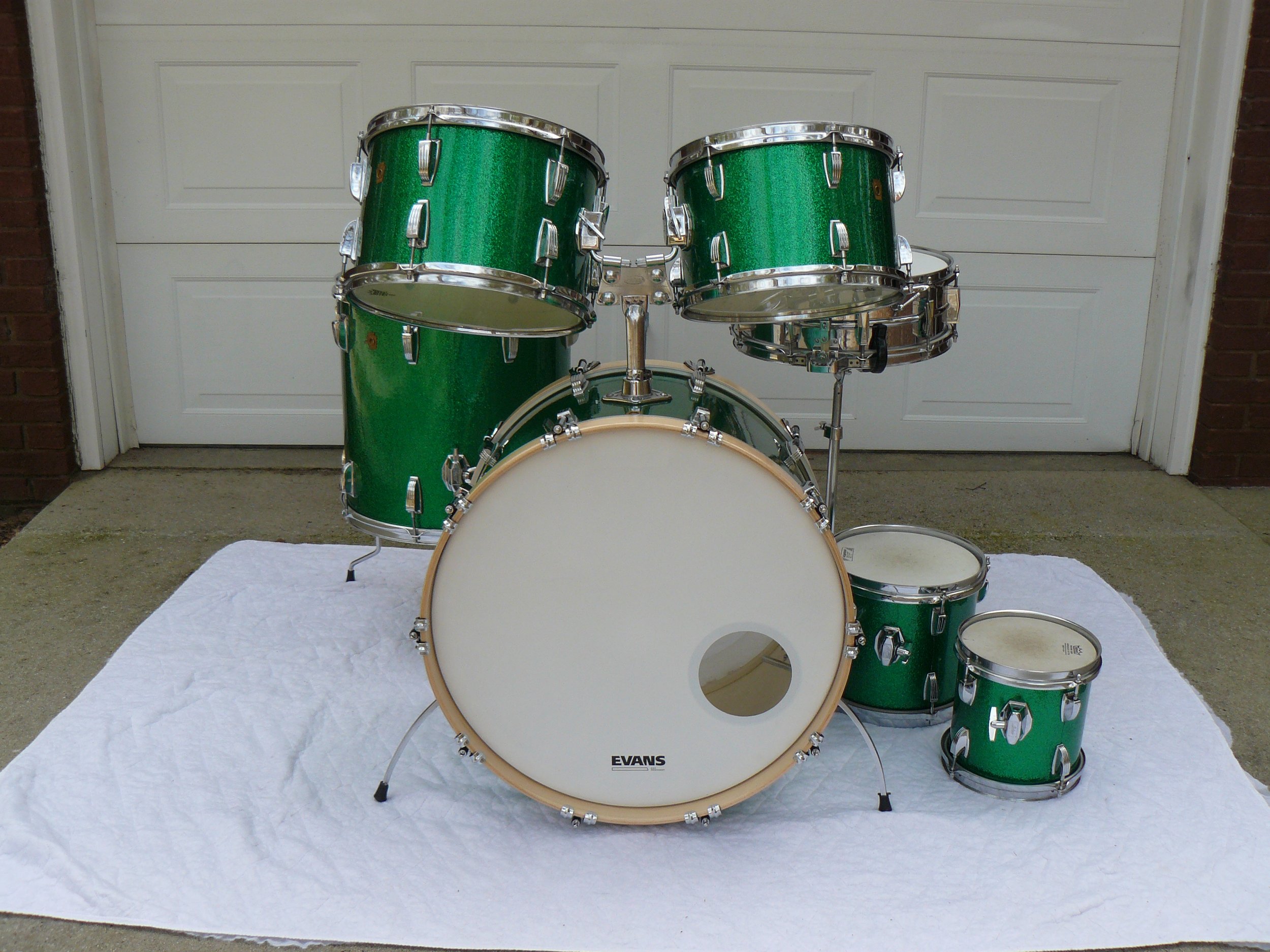
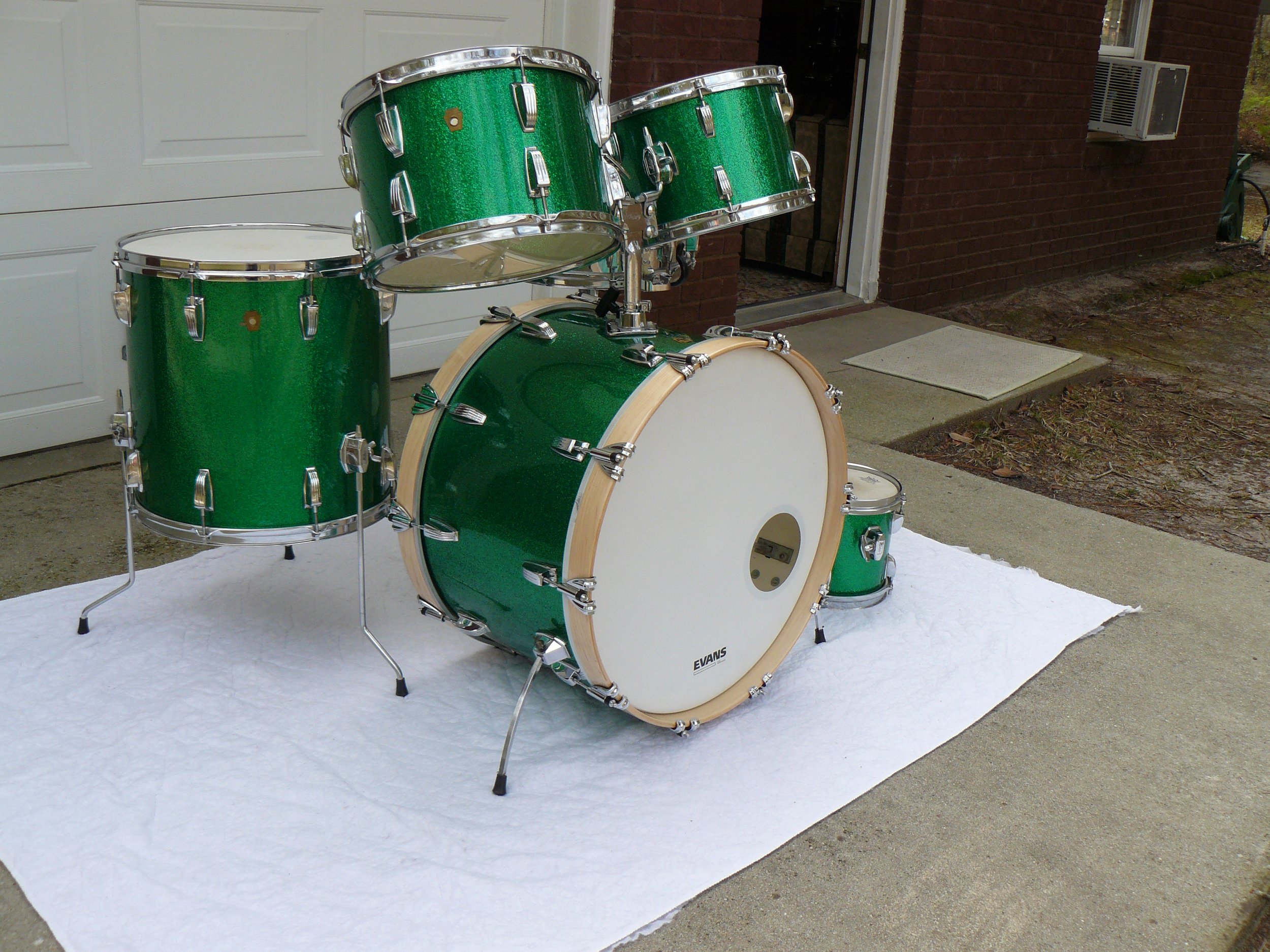


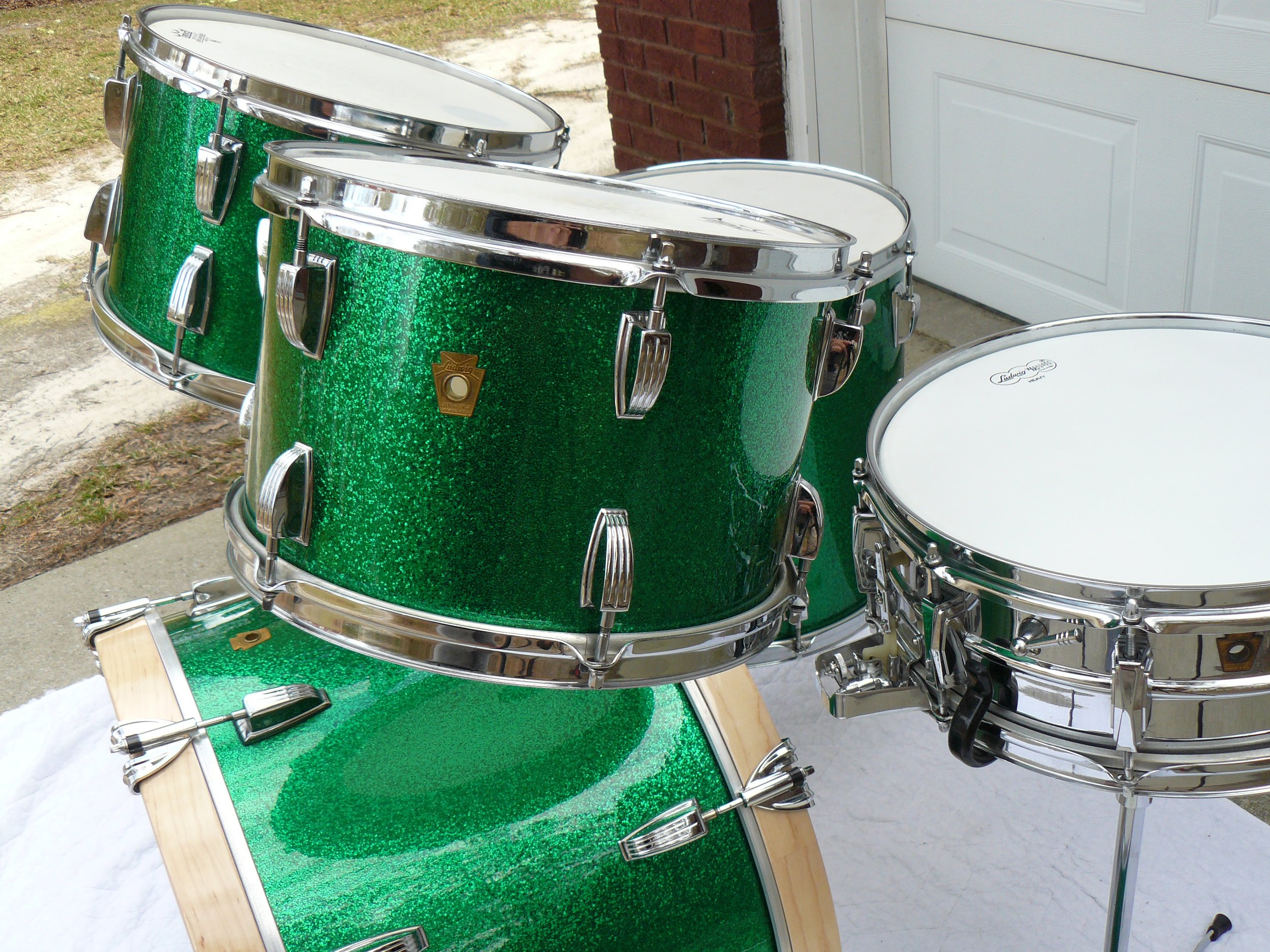
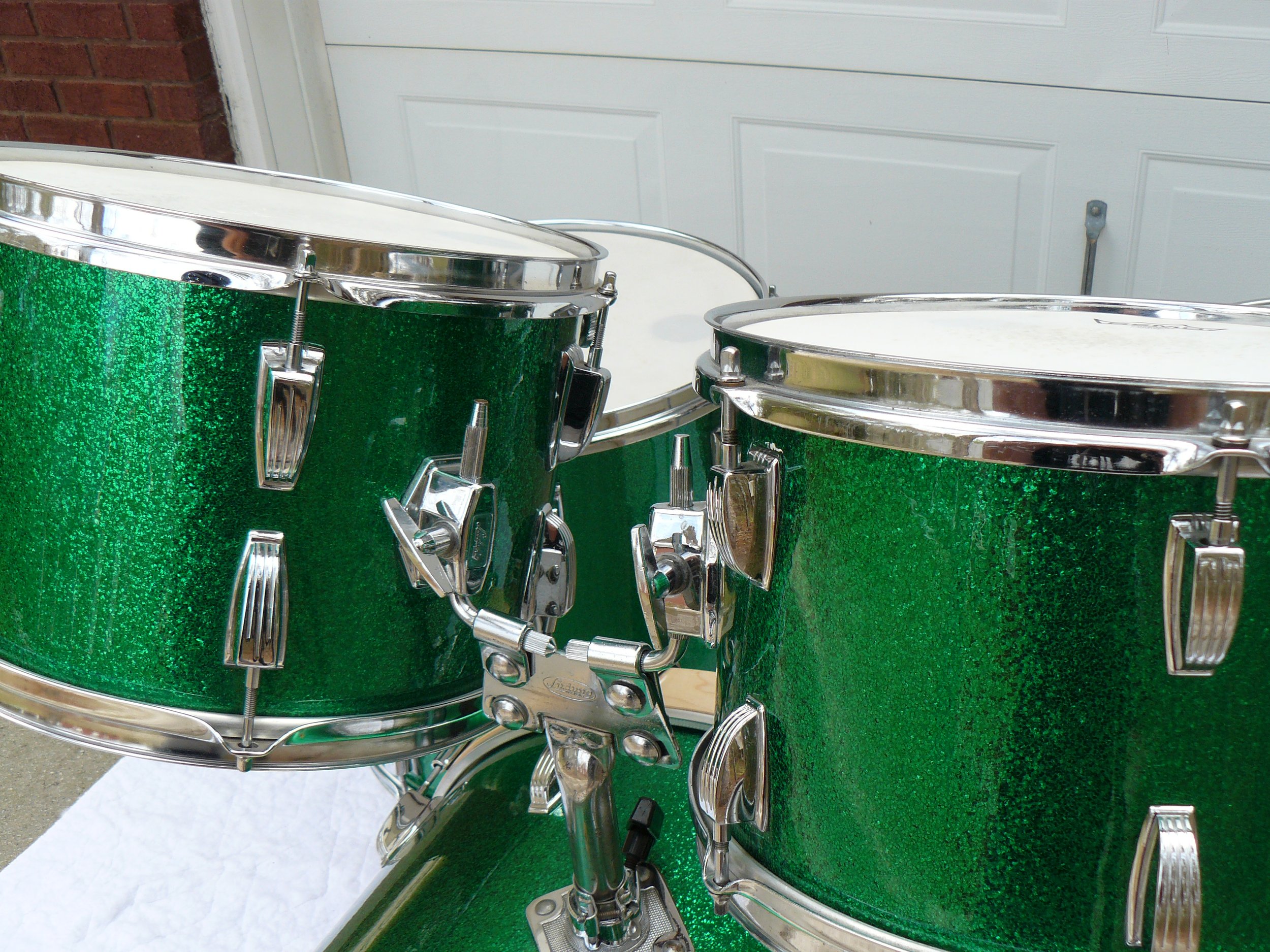

This is a 1960s Ludwig Hollywood set that I bought from my longtime friend Bill Pace, who by the way is doing fine. I talked to him this week and even though he doesn't get out and go as much as he once did, he is playing his drums and still buys and sells at times. He felt that the kit was in need of restoration, including a new finish, so this was his project 20 plus years ago. He said the finish was badly damaged and wanted to make them look and sound good again.
Read moreTwo 1920s L&L White Enamel/Deluxe Super Ludwig snares
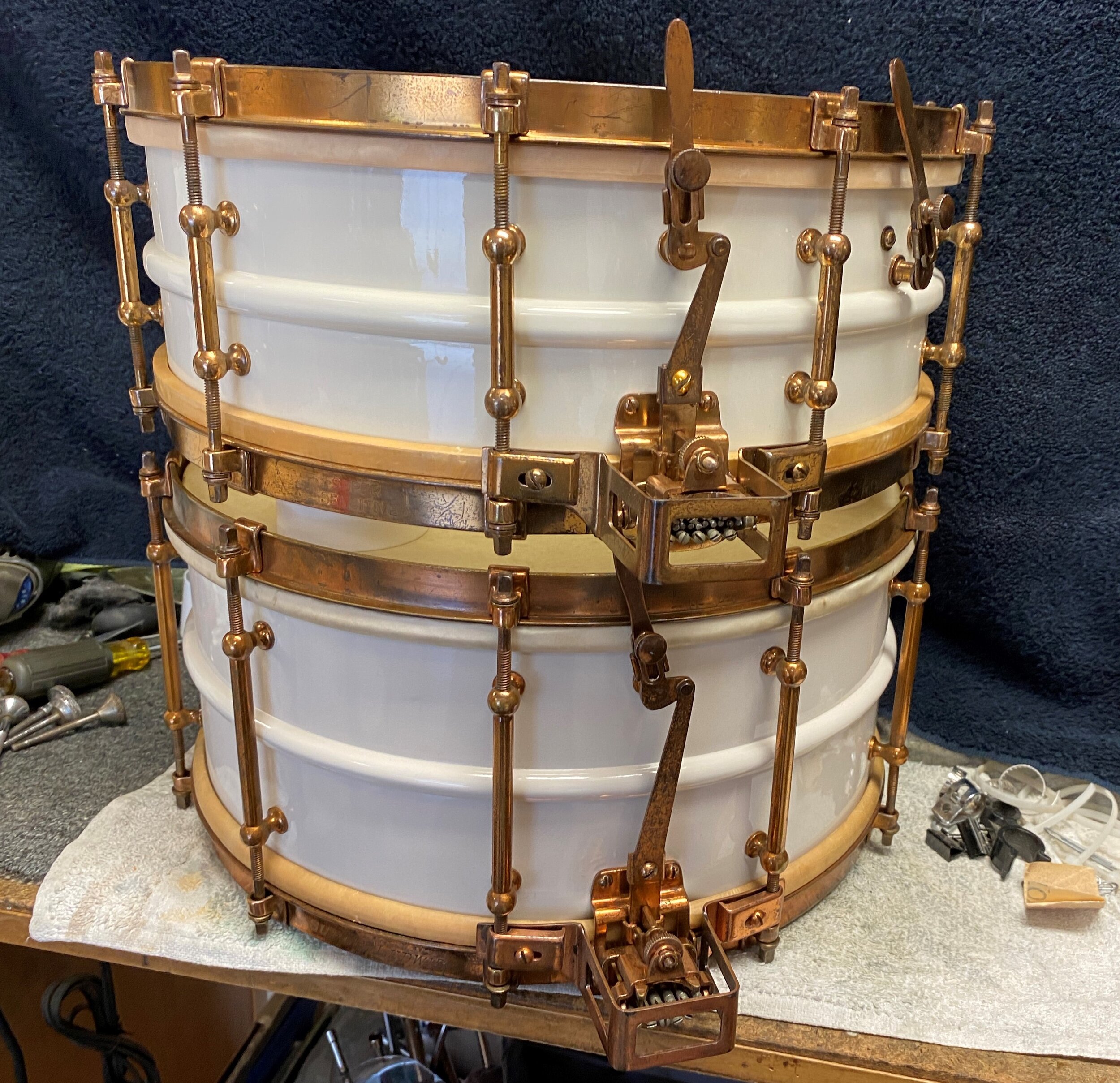
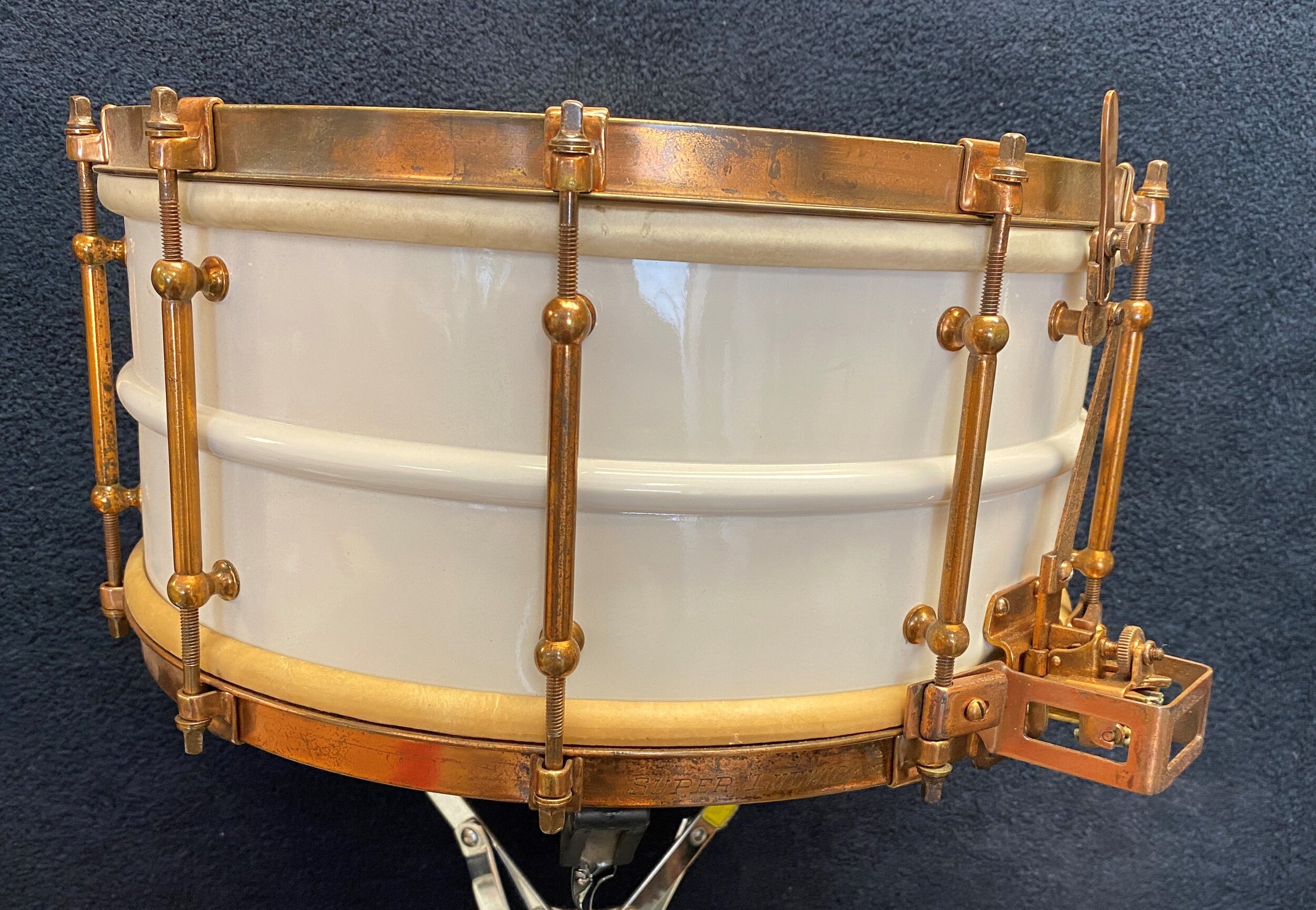
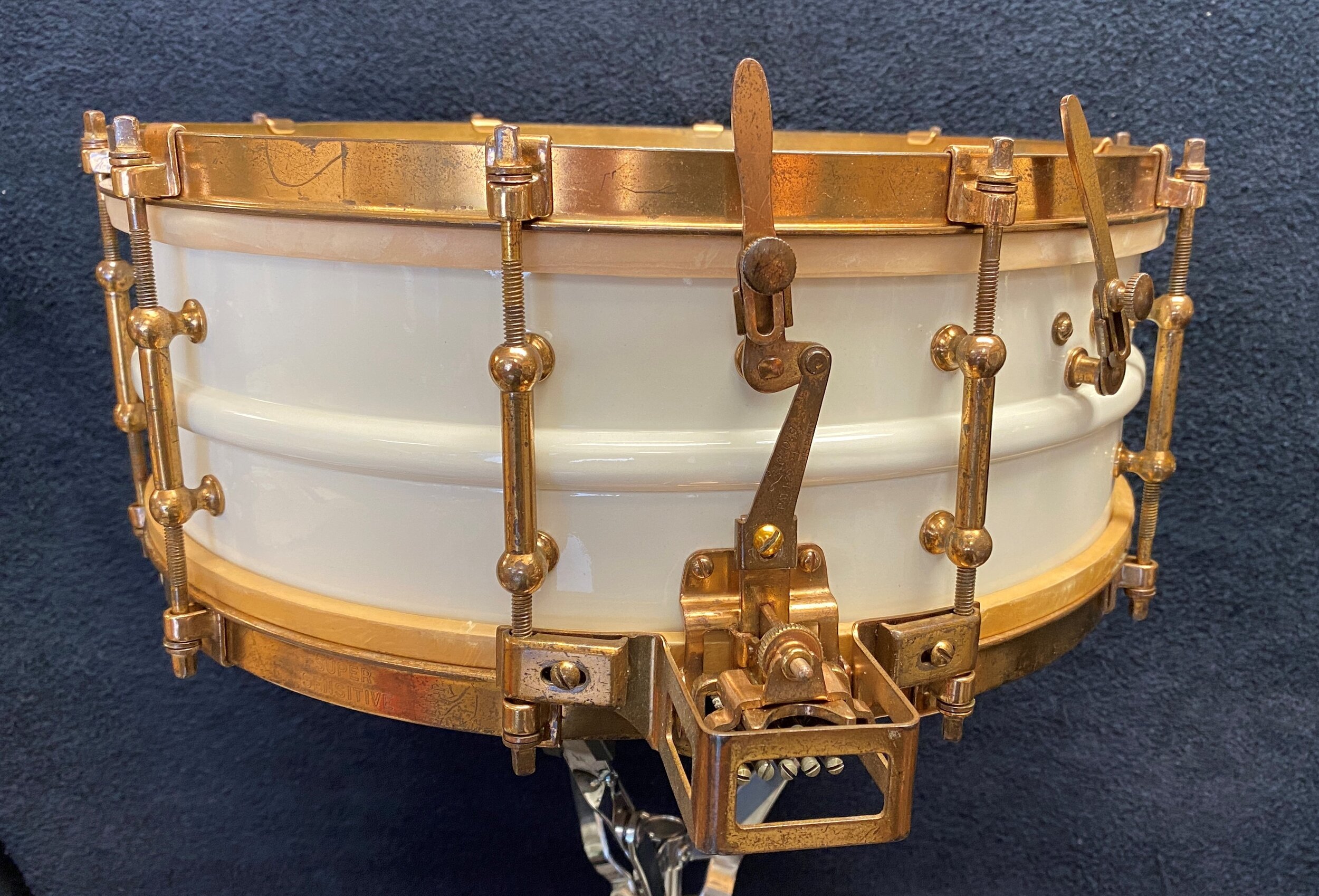
The 6.5 x 14 was another story...the shell came to me wrapped in lime green glitter contact paper. This looked – as my good friend John Aldridge would say – “as ugly as home made soap”, and it was.
Read more1926-27 LUDWIG & LUDWIG 4 x 14 “STIPELSILVER” (uncatalogued) DANCE MODEL


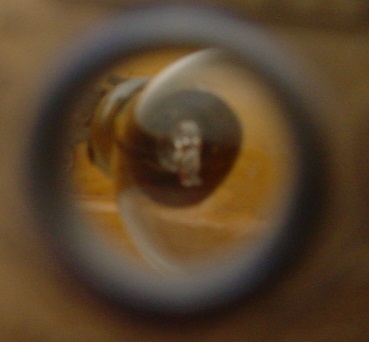
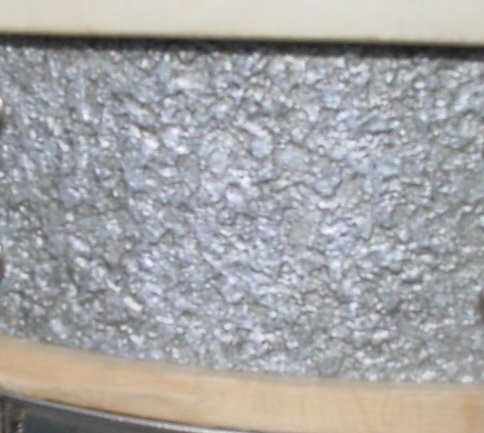

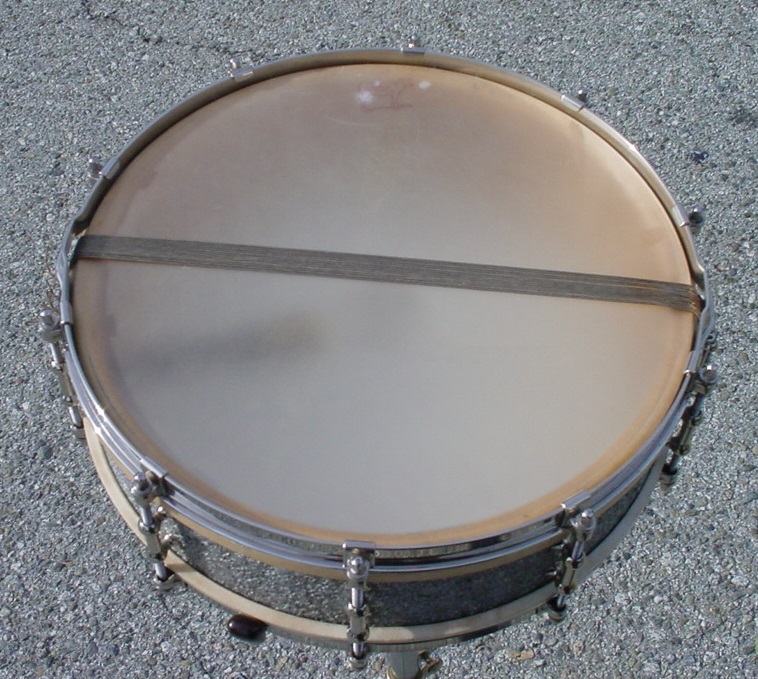
The drum in this article has a “Stipelsilver” finish, same texture as Stipelgold but with a bright silver hue. I believe that this drum is a one-off/special order for a few reasons that I will explain
Read more1960 Ludwig Downbeat Outfit No. 988P in Oyster Pink Pearl
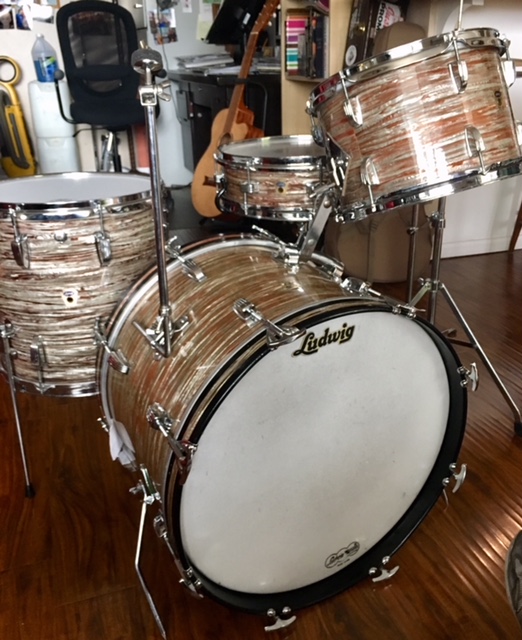






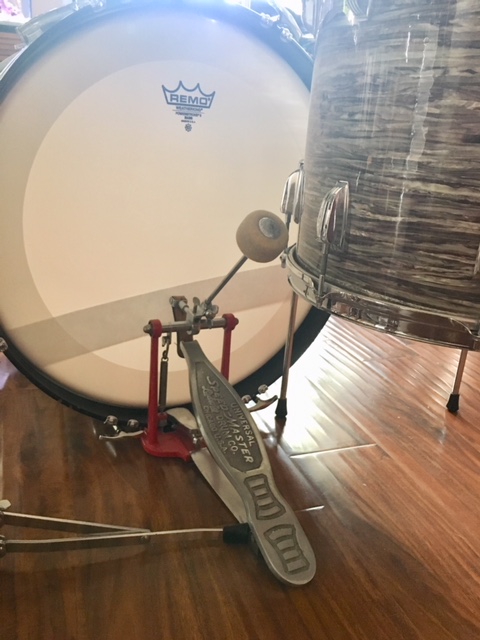







This kit is my personal "holy grail" set and as a Ludwig collector/player is pretty much at the top of the vintage list and falls, as I was told, under the "go and try to find another" category.
Read more1968 Ludwig Standard Kit S-300 in Lemon Strata
The Ludwig Standard line of drums were introduced in 1968 to be a lower end priced kit to compete with the flood of imports that were coming in at the time from overseas.
However, the great thing is that, like the Club Dates, you were getting the same shell found in the classic line shells of that time, just with different hardware (less expensive to cut costs).
Read moreCleaning and polishing vistalite and mylar finish drums
The best products we have found for cleaning and polishing Vistalite drums and mylar wrapped drums are made by Meguiars Mirror Glaze.
Read moreJohn Bonham’s Vistalite B&W Candy Stripe Kit
John Bonham’s Ludwig Vistalite Black & White Candy Stripe swirl drum kit used during his time with Led Zeppelin was originally given to music critic Chris Welch by Bonzo himself. It is one of the only kits outside of the Bonham estate.
Read more@ 1927 Ludwig DeLuxe Genuine Gold Trimmed Model Snare
I was at a loss to find any of the previous owners prior to Bun E. I keep wondering who was the drummer who bought and played this drum almost 90 years ago. I wish I knew…
Read more1970s Ludwig Blue Big Beat Vistalites
This set I am featuring from my collection is a 1970s blue Big Beat set. The clear and blue colors have been Ludwig's best sellers through the years. I suppose Amber and yellow also sold well thanks to the Bonham influence.
Read more1969 Ludwig Psychedelic Red Hollywood Drum Set
It's really warming up for us here in the deep south. I hope your Summer has begun well. I got out early this morning to photograph this drum set for my article and I am still sweating all over the drums as I set them up. I know this set is not mint, but they are a good example of this attractive and desirable finish. I have been writing for the magazine for a while and the reason they keep me around, I guess, is because I am just a regular collector like most of you. I am not a super rich man with unlimited funds to spend on drums. Boy if I were rich I would go wild at the drum shows and keep E-Bay and UPS very happy. Instead, I save for a while and look until I find a kit or snare that really turns me on. I have bought a few pieces every year for the past twenty years, and sold a few pieces now and then. I have sought to improve the collection as I go along. I will buy a set in a finish I like, and when the set in the same finish in better condition comes along, I'll buy it and sell mine. I really don't consider myself a hoarder. I don't have five matching drums in the same finish or anything like that. If I have an extra drum in a finish another collector wants I share up.
The set I am featuring this month is a beautiful Ludwig Hollywood set from 1969. The wrap is Ludwig's exclusive Psychedelic Red Pearl finish. The big drum companies of that day mostly shared the sparkle colors and pearl finishes on their drums, but no other drum company dared to offer this finish, so it was only on the Ludwig sets. Ludwig tried two other psychedelic finishes on their drums, but they were not as successful in sales compared to this awesome finish. I don't have the time nor words to describe what psychedelic means to us who were from the sixties, but suffice it to say we loved everything psychedelic during that period of our lives. The wild colors are a part of that movement, and these drums are very colorful. Someone described this finish as looking like a "frog in a blender." The badges are the Blue Olive parallelograms that replaced the Keystone badges that year. The interiors are natural maple that has been clear coated. The sizes are typical for the Hollywood sets. Bass drum 22"X14", floor tom 16"X16", mounted toms 13"X9", and 12"X8". The snare is a 14"X5" chrome Supraphonic. This was the type snare that went out with most of the sets sold.
This was one of the earliest sets I bought when I started my collection. When I was in high school, a friend got a double bass drum set of Ludwigs in this finish. When I saw those brand new Psychedelic red drums I couldn't believe how spectacular they looked. I never got over that, so I went looking to recapture that experience by owning a set like those. I told my good friend Bill Pace, who actually had a vintage drum store at that time, to let me know if he found a set I could buy. He called me one afternoon with the news that he had a set in his store if I wanted to see them. I took my son with me to share the excitement. We bought them and I have certainly enjoyed owning them ever since. They are not perfect, as I said, but if you get a chance to buy a set like this in almost any condition you should do it. The finish fades with time and light exposure. The green color is the first to go. Even faded they are still desirable.
I don't know if this will make the editors cut or not, but I also included a picture of a Ludwig factory Psychedelic wood shell Supraphonic re-issue snare drum Ludwig made for me just before they re-issued the color on sets fifteen years ago. I along with others had requested Ludwig re-issue the finish, and so I got one of if not the first one. The head was signed by Bill Pace who sold me the original kit and by the "Chief" Mr. Bill Ludwig.
How To Date 1960s Ludwig Drums By Serial Numbers
Prompted by the insurance industry, the new regulation mandated serial numbers on certain goods, including drums. "Up until then," said Mr. Ludwig, "some of our drums were date stamped and some weren’t - but none had serial numbers. Our dealers begged us to put them on, so we had our badge manufacturer imprint sequential numbers on the badges for all of our drums."
Read moreDrums & Gliders
Something different!
Read more1970s Ludwig Stainless Steel Hollywood Set
It's beginning to get warmer and there will be more yard sales, and sometimes drums appear out in people's front yards. I always brake for a yard sale to make sure there's not a sweet vintage drum for ten dollars in amongst all the junk. Check out the local pawn shops from time to time also. Tell the owner you would like a notification if any drums hit the floor. I have found some great snares and sets in pawn shops. Get your friends to be on the lookout for drums as they travel. I get a photo of a drum on my phone from friends quite often. Most of the drums they find are the newer variety, but I always tell them thanks for looking out for me. My friend Bill Pace puts an ad in the classified section in local towns. He says, "Old Drummer looking for Old Drums." It works for him, and he gets calls about drums families have in the attic. eBay and Craigslist aren't the only source of great vintage drums. Get out there and look for them, because if you don't, that brass Supraphonic will remain in that closet for many more years.
I have a real great set from my collection to show you this month. It’s a 1970s Ludwig Stainless Steel Hollywood Set. Ludwig introduced its line of stainless steel drums in the mid 1970s. These drums look so great and have a loud and powerful sound. They are also quite heavy. We all know John Bonham played a big Ludwig Stainless Steel kit soon after they came out with Led Zeppelin. The downfall of these drums was the cost to produce them. The same could be said about the Vistalite drums also. By the early 1980s the stainless steel shell drums were discontinued. They have been reintroduced in recent years for a limited run. The cost of the new stainless drums is very high. There are quite a few of these original wonderful sets out there for collecting and also playing. These drums from my collection are standard sizes: bass drum 22"X14, floor tom 16"X16", mounted toms are 13"X9", and 12"X8". The snare drum on display with the set is a 70s 14"X6.5" Supraphonic.
I have a couple of Stainless steel drum set stories I thought I would tell you. My good friend Lige Moore bought a great stainless steel set and loaned them to another friend. Our mutual friend's home burned with the stainless set inside. The Supraphonic snare drum was saved, but the rest of the kit burned. The shells came through the fire, but they looked pretty bad. Lige had a second 22" bass drum that I still have. I have his bass drum and snare drum in my stuff. Lige also gave me the shells that were burned, so I buffed them and sold them on E-Bay. They had no shine but they were still pretty cool. Another stainless steel story - I was doing some work for a man and the topic of drums came up. He told me he played and had a drum set in his house. I told him I also played and would really like to see his drums. I figured he would have an import set, but boy was I surprised to walk in to his drum room and find a flawless Stainless Steel set with all original hardware and Zildjian cymbals. I just never expected that set to be there in his house. He had bought them new in 1977 and he had never played them outside of his house. They were dusty and needed heads and a good cleaning to make them look like they had just come out of the music store. I asked him If he would like to sell them, but he said he didn't. I asked him about trading him a new set of Pearl or Tama drums for them and he said he might do that, but as of yet he hasn't. I'm not telling any of you where they are. I'm hoping he will let me replace them one day. My set is nice, but his is much nicer.
Make a comment if you have or play a Stainless steel drum set. I would like to get your feedback.
WIW? Ludwig Imperials?
Got something that you want to ask the community what’s it worth? Send it in and we’ll post it here. – NSMD NSMD,
I am very interested in purchasing a drum but I'm not certain who made it. I consider myself to have decent vintage knowledge but not after seeing this one. The shell has no name or stamp on it what so ever. Also very strange is that there is no center bead in the shell. It has no extra holes drilled in it. The lugs appear to be late 30's Ludwig Imperials. The strainer also looks to be Ludwig, later 20's to early 30's. There is a welded seam on the interior of the shell. Can you please help or give me an idea of what type of shell it might be.
Thanks, Lance
What do you think? Let us know in the comments below!
WIW? 40-50s Leedy Ludwig Kit
Got something that you want to ask the community what’s it worth? Send it in and we’ll post it here. – NSMD
Hello-
Here's an entry for What's It Worth: my uncle's old 40's-50's kit. Leedy Ludwig 20"bass and 13" tom. Not sure of franken-snare, has Leedy lugs, new bottom rim and snare throw off. I'm not a restorer, but I did get them player ready. Bass and mounted tom seem to be original, floor tom is his old high school marching drum recovered for tom use. I do have everything to make it back into the original marching share. All original Leedy hi-hat with 14" Zildjian cymbals. Leedy Ludwig bass drum pedal, with a clamp for mounted tom and clamp-on cymbal - older with 16" Zildjian crash-ride. No extra holes for tom or cymbal mounts. This what he was using until he bought his brand new set of '58 Gretsch Drums. They play and sound great. I know its hard to put a value on this unseen but they are in good -very good condition.
Thanks, Ronnie
What do you think? Let us know in the comments below!
1960s Ludwig Downbeat Set
The drum set from my collection that I want to feature this month is a 1960s Ludwig Downbeat Set in sparkling pink champagne pearl. Downbeat sets began in 1959. It is one of my all time favorite kits. I really love these drums for many reasons. Their sizes are one reason I love them. These are the size drums Ringo Starr played on the earlier Ed Sullivan shows. The Bass drum is 20"X14", the floor tom is 14"X14" and the mounted tom is 12''X8". Ringo referred to the Downbeat sets he owned as the "mini" kits. I used to have a hard time telling if a kit was a Downbeat set in photos, but I learned to count the bass drum T- rods. The Downbeat set has 8 lugs and the 22"X14" Super Classics have 10 lugs. Another way to tell is to look at the lugs on the mounted tom. The space is greater between the top and bottom lugs on the 12'' tom than the space on the 13" tom. The 13" tom used on the Super Classics has larger lugs, so the space between them is smaller.
Read moreThe Levon Helm Snare Drum
So the drum was given to Levon by Ringo, clearly played and signed by Levon to the son of another tremendously influential drummer, Richie Hayward. Four degrees of separation, perhaps? I was happy to win the auction, securing both drum for its history and the ability to help Seve in my own small way.
Read moreJuly 2014 - Red Headed Step Children
But what about all the vintage and rare drums that have been modified with extra holes, unoriginal parts etc.? What about those red headed bastard stepchildren?
It is my theory that they will become more and more desirable as the herd is thinned over the coming decades. What made me realize this was one particular seller at the Chicago Drum Show who asked me if there were going to be a lot of “hipsters” at my Nashville Drum Show. He said that in Austin, where there are hundreds and hundreds of working drummers in that busy music scene, they are buying “player" vintage kits and snares, not the collector level drums. They are buying them for the sound, not the collectability. It made me realize just how much the vintage drum world has grown and how the less than perfect old drums need to be preserved too.
Read moreTRIPLE Top Hat & Cane Restoration
MY TRIPLE TOP HAT AND CANE RESTORATION IS COMPLETE!!
The Ludwig Top Hat and Cane “Swing Sensation” drum set is considered by most collectors to be the holy grail of all vintage drum sets. Top Hats were first made in 1940. They appeared in the Ludwig and Ludwig catalog for just 2 years in 1940 and 41. It was the absolute best drum set money could buy. Ludwig and Ludwig’s slogan at the time was “Tops in the Drum World”. The Top Hats were their “flagship” drum set. It was the top of the tops. Nobody knows for sure how many of these sets were made, however it’s assumed that there were very few. At a staggering $353.85 (about $5,000.00 in today’s money), the set was extremely expensive. In early 1942 all drum production declined dramatically as the United States imposed metal rationing during World War II. All of these factors contributed to the a very small number of these sets ever being produced. Fewer than 15 of these sets are believed to still be in exist. There are many questions that revolve around the history of the legendary Top Hat sets. Hopefully this article will answer some of them and probably raise a few more.
1) 1940 Ludwig and Ludwig catalog cover with “Tops In The Drum World” slogan 2) Top Hat “Swing Sensation" cataloge page
Initially the Top Hat finish was only available on the "Swing Sensation” set. This model was a complete outfit that included stands, cymbals, woodblock, and cowbells. It even included sticks and brushes. The drum sizes included a 7” x 14” snare, a 14” x 26” bass drum and 7” x 11”, 9” x 13” and 14” x 16” double tension toms”. The cymbals, small toms, bells and woodblock mounted to the bass drum on an "1120 Universal Trap Rack”. This ingenious arched rail mounting system attached to the batter side bass drum hoop and rested on top of the bass shell on 4 rubber feet. The floor tom sat in a basket style floor stand.
Top Hat drums have surfaced in sizes including 28” bass drums, 14” floor toms and tack bottom toms with date stamps as late as 1948. Presumably these were special order drums that were made some time after the initial offering.
I've had the extreme good fortune to have owned 6 of these Top Hat sets. I never really searched for any of them. They all just found their way to me. I’ve always had great luck when it comes to finding vintage drums. If there’s such a thing as “Drum Karma” then I definitely have it. I still have 3 of these sets. I decided that these drums should be restored to as close to their original magnificence as possible. Every drum (14 in all) required at least some work. Most of the drums were already in excellent condition. Some needed some minor repairs and some were missing a few parts. The biggest part of the restoration was machine polishing all of the shells and nickel hardware. All of the drums had already been meticulously hand cleaned and polished but it was clear that they could be dramatically improved by machine buffing. It’s pretty amazing what you can do with a power buffing wheel. It’s also pretty amazing how quickly you can destroy a drum if you make a mistake. One false move and you’re dead!!
Power buffing the shells eliminated minor scratches, and brought back most of the original color and shine. There was some concern that the black Top Hat graphic might buff off of the shell. Upon reading the original catalog description we discovered this would not be a problem. “The Top Hat design is actually a part of the shell and not "pasted on” or painted on the outside”. Power buffing the nickel hardware removed minor scratches, pitting and cloudiness and made it shine like new.
The first step in the project was to completely disassemble all 3 sets. It soon became apparent that we needed to keep everything extremely well organized. You can imagine the potential confusion as we would be sending hundreds of small parts all over the country. I called my good friend and vintage drum historian Paul Black to help me keep everything in line. Paul made sure every nut, bolt and washer was meticulously labeled and organized. This meticulous organization took a little extra time but ultimately saved us a huge amount of time in the end. Not one part was lost or misplaced. I always enjoy working with Paul. He really knows his drums and we get along extremely well. Paul has a very unique sense of humor. We kept our selves laughing the whole time.
The following is a brief description of each of the 3 sets and the details of their individual restorations.
The Wood Hoop “Hank Leja” Set
Hank Leja was a popular mid-western drummer who played in a variety of local swing and dixieland bands. He bought his Top Hat set brand new in the early 40s and played it throughout his entire career. Hank died a few years ago and his daughter contacted me after she inherited his beloved drums. After several months of negotiating I received what remained of Hank’s Top Hat set. By the time Hank passed the original bass and snare had disappeared. The snare met an unfortunate end after being loaned to an aspiring 5th grade drummer who apparently didn't cherish it as much as Hank did. Nobody knows exactly what happened to the bass drum. Fortunately, my great friend and long time vintage drum aficianado Tony Lewis had located an incomplete Top Hat set with a 26”,13” and a snare in Toledo, Ohio a couple years earlier. I’d purchased them and stuck them in my back room waiting for their matches to surface. Drum karma strikes!
1) A young Hank Leja with his brand new Top Hat and Cane Swing Sensation drum set. Circa early 1940s. 2, 3) Hank Leja in the 1970s with his “modernized” tom mounts.
I was extremely fortunate to receive a collection of photos that document the evolution of Leja's set throughout it’s 70+ year run. In the earliest photo, a fantastic studio portrait of a young Hank Leja with his beautiful new Top Hat drums, you can see the most unique characteristic of this particular set. The 11” and 16” toms both have white lacquered wooden hoops. I've never seen or heard of any other wood hoop Top Hat sets. Why the 13” tom has metal hoops is anyone’s guess. What is clear from the early photo is that it was like that from the start. Another unique detail about this set is that all 3 toms each have 2 separate date stamps, 11/41 AND 6/42. Go figure??
The 11” tom got mis-placed during shipping. The shippers knew they had it but were just not sure where. It took several months to locate it so the restoration of the rest of the drums had to begin with out it. When I finally received the 11” tom I discovered it need considerable attention. The wooden hoop had separated at the seam, a new tom mount had been mounted on the shell and the wrap and hardware were definitely showing their age. I sent it to Matt Sinyard at the Bonzo Drum Company in Florida. I’d seen a remarkable restoration that Matt had done on one of Buddy Rich's 1950s WFL sets and knew the drum would be in good hands. He easily repaired the damaged wooden hoop. For the sake of continuity, we decided to replace the metal hoops on the 13” tom so that all the tom hoops would match. Matt modified a set of old Slingerland wooden hoops to look virtually identical to the Ludwigs. At this point he repainted all the wooden tom hoops in white lacquer using the original 1940s photo as a reference. Matt is also a master with the buffing wheel. We decided to experiment on the 11” tom to see how well the finish could be restored. Once I saw the dazzling results it was clear I needed to have the entire Top Hat collection buffed. Shipping the 13 remaining shells across the country was too risky and expensive. Fortunately, my old friend and expert drum builder Jerry Garcia from Garcia Custom Drums is right here in Seattle. Jerry painstakingly buffed every remaining shell. Soon, over 70 years of scuffs and fading were gone and the 1940s shells were shining like a new dime!
There were a few small holes that needed filling after Hank “updated" some of the hardware during the 1970s. I sent them to restoration guru Jack Lawton to work his magic. Jack does amazing work. He did a beautiful job of matching the pearl finish and then hand painting the black lines where the Top Hat graphic had been drilled through. You have to look extremely close to even find the repaired holes.
Mike Curotto coordinated the buffing of the nickel hardware on all 3 sets. He knows a couple guys in California that do expert metal restorations. They have done many restorations on drums in Mike’s vast snare collection (practically a full time job right there!). These guys are total pros and are very experienced working with drum parts. As my luck would have it both guys got really sick as soon as I sent them my hardware. They had to shut down their shop for over a week, right as my project was supposed to start. This of course put them way off schedule and my job kept getting pushed back. Good things come to those who wait. I eventually got everything, almost 400 pieces. Every part looked spectacular. Nothing damaged, lost or mixed up. Just look at the before and after photos to see what an incredible job they did.
The Metal Hoop Set
I acquired this set locally from the nephew of the original owner. Over 10 years ago the nephew comes into my shop carrying a paper bag and asking questions about restoring old drums. When I ask what kind of set he’s restoring he proceeds to pull a beautiful Top Hat snare out of his bag. I tell him he has a very valuable set and encourage him to let us give it the full professional restoration it deserves. He’s adamant about doing the restoration himself as the set has great sentimental value to him. I also tell him that if he ever wanted to sell it that I would like to buy it. Again, he has a great sentimental attachment and says he could never sell it. I send him home with a bottle of shell polish and some basic restoration tips. Over the next several years the guy becomes a pretty regular customer. Every time he comes in I ask him how the restoration is coming. Every time the same answer “I haven't started yet but I’m going to really soon”. This continues for around 10 years. One day he shows up with the set in the back of his truck and and wants to sell it. I had just sold one of my other Top Hat sets and assumed I would never see another one in my life. Drum karma strikes again! He leaves with a big fat check. I get this Top Hat set (which included an un-opened bottle of drum polish).
This set is by far the best looking Top Hat set I’ve ever seen. There was nothing to repair. Once the shells and hardware were buffed it looked virtually brand new. I would venture to say this is the nicest Top Hat set in the world. I’ve seen lots of them and this one tops them all. If there’s a better one out there I would love to see it.
The 4 Piece Set
This set was acquired from a prominent mid-west drum collector. He’s a good friend of mine who knows more about vintage drums and the vintage drum industry than anyone I know. We talked about this set for years and eventually worked it into a trade. This set needed the most restoration of all the sets. The hardware looked good but the shells were definitely showing their age. There were a few extra holes on some of the drums and the finish on the 11” tom and the snare had cracked and were peeling up. Jerry Garcia back in Seattle did a great job of repairing the finish. He glued down the lifting finish and concealed the crack lines as much as possible. Then he gave the whole set a good buffing and really made them shine. This set really came back to life! In it’s own special way I think it’s my favorite. It has a lot of vibe. This set never had a floor tom or the rail mounting system that the other sets had. The toms mount to the bass drum hoop. Both of the toms are date stamped 8/41. The bass and snare are stamped 7/41.
The whole project l took about 3 years. It was a huge undertaking. It required a tremendous amount of time, patience, energy, organization and money. Did I mention money? I’m extremely grateful to all of the experts who contributed their knowledge, experience and skill to this restoration. It’s extremely gratifying knowing that these iconic drums are now close to their original spectacular condition.
So now what? What do I do with 3 Top Hat sets? As much as I’d love to keep them all I’m afraid I just don’t have room. My plan is to find new homes for 2 of the sets. Whichever set remains I’ll keep and play in my studio. Hopefully I’ll be playing them as long as Hank Leja did.
I welcome any questions or comments. I have lots more photos if any one is interested.















